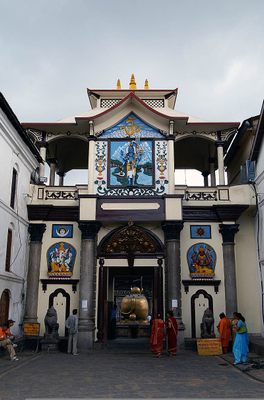About
The Pashupatinath temple complex is part of UNESCO’s World Heritage Site. The temple’s age is not exactly certain, but legend indicates its existence to date back to 400 BC.
The complex includes 518 temples, buildings, and structures. The main temple is designed as a pagoda structure, located within the fortified courtyard, and guarded by Nepalese military force and semi-military Nepali police. Features of the main pagoda include carved wooden rafters, cubic sculptures, with two-level roofs covered with copper and gold sheets. Four main doors to the pagoda are covered with silver sheets, while the pinnacle is gold.
The temple has two interior rooms where the Pashupatinath (AKA Shiva) idol is placed. Near the temple’s western door stands a bronze statue of Nandi bull, the sacred vehicle or vahana of Shiva. Temples in the complex are designed in Vaishnav (Vishnu) and Shaiva (Shiva) tradition. The main idol is a stone deity with four faces representing Shiva’s various aspects, Sadyojata (or Barun), Vamadeva (or Ardhanareshwara), Tatpurusha, Aghora & Ishana (imaginative). Facing the four directions as well as zenith, they represent the five primary elements (earth, water, air, light, and ether).
Unlike other Shiva lingams in India and Nepal, this Pashupati Shiva idol is always in its golden cover except during prayer. Pouring milk and water from the Ganges river (ganga jal) which are standard acts of Hindu ritualistic worship is possible only during the abhisheka prayer times and conducted only by the main priests. The Pashupatinath idol can be touched only by the main Bhatt priests while the Bhandari priests assist the Bhatt priests during daily pooja worship rituals.
Know Before You Go
The April 2015 Nepal earthquake affected the Pashupatinath temple complex, where some of the outer buildings were severely damaged. Only practicing Hindus, Buddhists, Sikhs, and Jains of Indian origin are allowed into the inner temple courtyard. Hindus of western descent and non-Hindus are given restricted entry to the temple courtyard.
Take a taxi from Kathmandu city center to Pashupatinath, which will cost around $15. Guides cost about $10 while a non-Hindu can enter the temple for a $10 entrance fee. The inner temple courtyard is open from 4 AM to 7 PM, while the inner temple is open from 5 AM to 12 noon for morning worship and viewing and then 5 PM to 7 PM for the evening prayer and viewing.
Community Contributors
Added By
Published
April 25, 2019
Sources
- http://pashupatinathtemple.org/visit-pashupatinath-temple/
- http://pashupatinathtemple.org/
- http://www.sacred-destinations.com/nepal/kathmandu-pashupatinath
- http://pashupatinathtemple.org/visit-pashupatinath-temple/
- http://www.sacred-destinations.com/nepal/kathmandu-pashupatinath
- http://pashupatinathtemple.org/
- http://pashupatinathtemple.org/
- http://pashupatinathtemple.org/visit-pashupatinath-temple/
- http://www.sacred-destinations.com/nepal/kathmandu-pashupatinath














